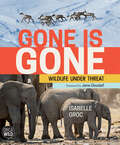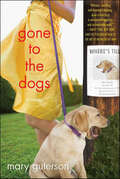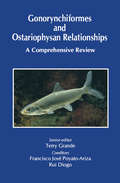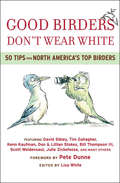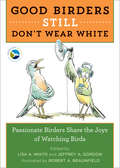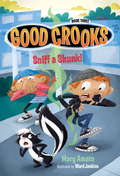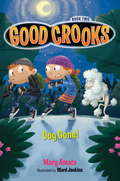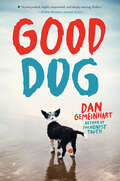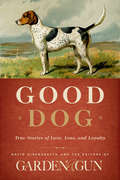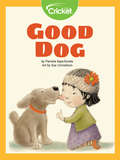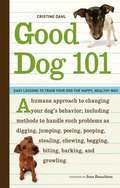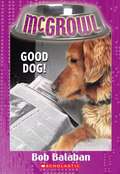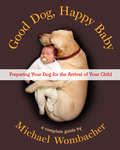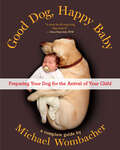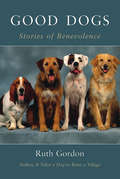- Table View
- List View
Gone but Not Furgotten: A Cat Cafe Mystery (Cat Cafe Mystery Series #6)
by Cate ConteIn Gone but Not Furgotten, the sixth in Cate Conte's Cat Café beloved cozy mystery series, Daybreak Island has a killer on the loose…and this villain isn’t afraid to use their claws. Maddie James has big plans for the summer season at JJ's House of Purrs. But when her friend, master meditator and Tai Chi teacher Cass Hendricks, brings a potential animal hoarding situation to her attention, Maddie has to refocus her attention on the furry felines who may need a helping paw. Cass has brought his Zen teachings to Fisherman's Cove—a tiny, working class town on Daybreak Island—and one of his students, Laurel, has been on the receiving end more than one hissy fit from her neighbors, mostly because of her cats. When Maddie and Cass go to Laurel's to check out the situation, not only do they find a plethora of cats in need, but also a dead body. Laurel appears to have had an unfortunate accident falling down her stairs, but Maddie gets a sneaking suspicion that something more sinister might be behind her death. When she voices her concerns, she's horrified that it's Cass who falls under suspicion. With Grandpa Leo's help, Maddie has to dig into the secrets this small community is keeping close to find out why Laurel really died before Cass is put behind bars . . . or the killer strikes again.
Gone is Gone: Wildlife Under Threat (Orca Wild #2)
by Isabelle GrocWhy do species become endangered? How are scientists learning about endangered wildlife? What are people doing to conserve species and how can young people help? This book is richly illustrated with unique photos that Isabelle has taken over many years of observing endangered species in the field alongside the people who work to conserve them. Throughout, the author shares enchanting encounters and personal field stories: watching narwhals socialize in the Canadian Arctic, getting close to a Laysan albatross raising chicks on a remote Hawaiian island, spotting a rhinoceros on safari and even swimming with sea lions in the Galápagos Islands. Gone is Gone will inform, intrigue and inspire readers to take small steps toward big changes for endangered species around the world. The epub edition of this title is fully accessible.
Gone to the Dogs: A Novel
by Mary GutersonRena never meant to steal her ex-boyfriend's dog. She was just casually driving by his new house, taking stock of his new life, when the dog invited himself into her car...Okay, so she stole the dog. But how could Brian, her boyfriend of seven years (not to mention "unofficial" fiancé), have done this to her? Fallen off the face of the earth, only to resurface with a gorgeous, live-in girlfriend and live-in dog? Honestly, a girl can only take so much. Besides, how could a yellow lab as great as this one be happy living with those two very bad people?Unfortunately, being a dog-napper is the least of Rena's problems. Her mother's dating a "potential" serial killer, her sister's having an identity crisis and she's the target of one hopeless fix-up after another—most recently, the highly moral Chuck, who just happens to know all about Rena's dog-napping escapades. If Rena wants to straighten things out, she'll have to face up to the choices she's made, the dreams she's put on hold, and the man who broke her heart.
Gone with the Whisker (A Bookmobile Cat Mystery #8)
by Laurie CassA friendly feline and a feisty librarian merrily roll along in the newest Bookmobile Cat mystery...until murder stops them in their tracks! It's the summer season in Chilson, Michigan, and the town is packed with tourists ready for a fabulous Fourth of July fireworks show. Minnie Hamilton and her rescue cat, Eddie, have spent a busy day on the bookmobile, delivering good cheer and great reads to even the library's most far-flung patrons. But Minnie is still up for the nighttime festivities, eager to show off her little town to her visiting niece, Katrina. But then, during the grand finale of the fireworks display, Katrina discovers a body. Minnie recognizes the victim as one of the bookmobile's most loyal patrons. And she knows she—and Eddie—will have to get to the bottom of this purr-fect crime.
Gonorynchiformes and Ostariophysan Relationships: A Comprehensive Review (Series on: Teleostean Fish Biology)
by Terry GrandeAn understanding of gonorynchiform morphology and systematic inter- and intra-relationships has proven vital to a better understanding of the evolution of lower teleosts in general, and more specifically of groups such as the clupeiforms (e.g., herrings and anchovies), and ostariophysans (e.g., carps, minnows and catfishes). This book examines the
Good Birders Don't Wear White: 50 Tips From North America's Top Birders
by Kenn Kaufman Scott Weidensaul Lillian Stokes Bill Thompson III Julie Zickefoose Tim Gallagher Robert A. Braunfield Don StokesDavid Sibley, Don and Lillian Stokes, and many more share their inside tips—and witty observations—on the birding life. The biggest names in birding dispense advice to birders of every level—on topics ranging from feeding birds and cleaning binoculars to pishing and pelagic birding—in these lighthearted essays accompanied by illustrations. Whether satirizing bird snobs or relating the traditions and taboos of the birding culture, this collection of wisdom is as chock-full of helpful information as it is entertaining. &“The book is a delight to read and will generate new enthusiasm for the hobby. The 25 black-and-white line drawings are hilarious.&” —Booklist
Good Birders Still Don't Wear White: Passionate Birders Share the Joy of Watching Birds
by Kenn Kaufman Michael O'Brien Pete Dunne Bill Thompson III Julie Zickefoose Richard Crossley Robert A. BraunfieldAvid North American birders share wit, wisdom, advice, and what fuels their passion for birds. Birding gets you outside, helps you de-stress, exercises your body and mind, puts your day-to-day problems in perspective, and can be lots of fun. Birders know this, and in this collection of thirty-seven brief essays, birders from diverse backgrounds share their sense of wonder, joy, and purpose about their passion (and sometimes obsession). From the Pacific Ocean to Central Park, from the rainforest in Panama to suburban backyards—no matter what their habitat, what good birders have in common is a curiosity about the natural world and a desire to share it with others. In these delightful essays, each accompanied by an endearing drawing, devoted birders reveal their passion to be fulfilling, joyful, exhilarating, and maybe even contagious. Contributors include many well-known birders, such as Richard Crossley, Pete Dunne, Kenn Kaufman, Michael O'Brien, Bill Thompson, and Julie Zickefoose—and a portion of the proceeds goes to the American Birding Association, North America's largest membership organization for active birders.
Good Boy, Fergus!
by David ShannonFollow Fergus as he experiences the perfect doggy day -- well, except for his bath, of course! From chasing cats and motorcycles to being scratched on his favorite "tickle spot," David Shannon's newest sweet and silly character will inspire young readers to laugh out loud at his mischievous antics. Fans of Shannon's previous books will love reading all about this naughty but lovable dog!
Good Boy, Fergus!
by David ShannonMeet Fergus, the canine star of the upcoming book from Caldecott Honor artist David Shannon. Much like Shannon's beloved characters, David and Alice, the adorable Fergus is always getting in trouble!Follow Fergus as he experiences the perfect doggy day--well, except for his bath, of course! From chasing cats and motorcycles to being scratched on his favorite "tickle spot," David Shannon's newest sweet and silly character will inspire young readers to laugh out loud at his mischievous antics. Fans of Shannon's previous books will love reading all about this naughty but lovable dog!
Good Boy: My Life in Seven Dogs
by Jennifer Finney BoylanFrom bestselling author of She’s Not There, New York Times opinion columnist, and human rights activist Jennifer Finney Boylan, Good Boy: My Life in Seven Dogs, a memoir of the transformative power of loving dogs.This is a book about dogs: the love we have for them, and the way that love helps us understand the people we have been. It’s in the love of dogs, and my love for them, that I can best now take the measure of the child I once was, and the bottomless, unfathomable desires that once haunted me.There are times when it is hard for me to fully remember that love, which was once so fragile, and so fierce. Sometimes it seems to fade before me, like breath on a mirror.But I remember the dogs. In her New York Times opinion column, Jennifer Finney Boylan wrote about her relationship with her beloved dog Indigo, and her wise, funny, heartbreaking piece went viral. In Good Boy, Boylan explores what should be the simplest topic in the world, but never is: finding and giving love.Good Boy is a universal account of a remarkable story: showing how a young boy became a middle-aged woman—accompanied at seven crucial moments of growth and transformation by seven memorable dogs. “Everything I know about love,” she writes, “I learned from dogs.” Their love enables us to pull off what seem like impossible feats: to find our way home when we are lost, to live our lives with humor and courage, and above all, to best become our true selves.
Good Crooks Book Three: Sniff a Skunk!
by Mary Amato Ward JenkinsA funny, silly series perfect for fans of Dav Pilkey, Tony Abbott, and Nancy Krulik. Mary Amato is a star of state master and children's choice lists and returns to the age category of her popular Riot Brothers chapter book series with this new venture.Good Crooks Book Three: Sniff a Skunk! brings back our favorite pair of do-gooder crooks in a hilarious adventure about an odiferous encounter with a skunk. The first two books in the series are Book-of-the-Month-Club selections. Releases simultaneously in hardcover (ISBN 978-1-60684-598-1) and eBook (ISBN 978-1-60684-600-1) formats.
Good Crooks Book Two: Dog Gone!
by Mary Amato Ward JenkinsA funny, silly new series perfect for fans of Dav Pilkey. Mary Amato is a star of state master and children's choice lists and returns to the age category of her popular Riot Brothers chapter book series with this new venture. When their parents steal a monkey from the zoo to help them pick pockets, our heroes rush into action and return the wily animal using disguises, inventions, and old-fashioned shoe leather. They also learn what a monkey can do in 11 minutes: 1) Stick his fingers in your right nostril. 2) Lick your eyebrows, pick his teeth, and then wipe his finger on your shirt. Giggles and guffaws will be the result of anyone reading Book One of Good Crooks.
Good Dad Diego
by Brenna MaloneyIn this humorous celebration of fatherhood, an irresistably adorable (and real!) pug shows what it takes to be a good dad.Diego is a dog, but he has one of the toughest jobs in the world. Is he a ninja? Nope. Is he a superhero? Nope. Is he a king or a police officer or the president? Nope. Nope. Nope. Diego is a DAD. And that requires the patience and fortitude of all of these positions combined . . . as Diego--an adorable pug--demonstrates in this laugh-out-loud photographic picture book. Admonitions and chores may be somewhat different for dogs: "Stop chewing on the furniture!" "Don't eat cat barf!" But Diego does everything out of love . . . and we get to see the objects of his affection at the end of the story: pug puppies!!
Good Dog
by Dan Gemeinhart<P>Brodie was a good dog. And good dogs go to heaven. <P>Except Brodie can't move on. Not just yet. As wonderful as his glimpse of the afterlife is, he can't forget the boy he left behind. The boy he loved, and who loved him in return. <P>The boy who's still in danger. <P>So Brodie breaks the rules of heaven. He returns to Earth as a spirit. With the help of two other lost souls -- lovable pitbull Tuck and surly housecat Patsy -- he is determined to find his boy and to save him. <P>Even if it costs him paradise. Even if he loses his eternal soul. <P>Because it's what a good dog would do.
Good Dog
by David Dibenedetto Editors of Garden GunGarden & Gun magazine's aptly named Good Dog column is one of the publication's most popular features. Now editor in chief David DiBenedetto and the editors of Garden & Gun have gathered their favorite essays as well as original pieces for this must-read collection of dog ownership, companionship, and kinship. By turns humorous, inspirational, and poignant, Good Dog offers beautifully crafted stories from such notable writers as P. J. O'Rourke, Jon Meacham, and Roy Blount, Jr. From the troublemakers who can't be fenced in to the lifelong companions who never leave our sides, this one-of-a-kind anthology showcases man's best friend through all of his most endearing (and maddening) attributes.ing--attributes. By turns inspirational and humorous (just like the dogs we love), Good Dog is a must-have collection for dog lovers everywhere.
Good Dog
by Maya GottfriedIn this heart-stealing picture book, fine artist Robert Rahway Zakanitch gives us 16 masterful, soulful, impossibly expressive portraits of dogs, and Maya Gottfried wonderfully captures their voices and inner personalities in 16 enchanting poems. It's a doggie delight! These dogs beg to be patted, tickled, scratched, and ruffled. Which one will be your best friend?
Good Dog
by Pamela KapchinskeZoey is trying to train her dog to obey commands, but he won’t listen to her! She must come up with a new plan—she decides to train him to be her best friend! Will she be successful?
Good Dog 101: Easy Lessons to Train Your Dog the Happy, Healthy Way
by Cristine DahlAuthor and noted Seattle dog trainer Cristine Dahl has created this revolutionary step-by-step manual to teach dog owners how they can humanely and easily train their dogs to change problem behaviors. The book is organized by individual problem scenarios where very sort of bad behavior is addressed, whether it's if the dog compulsively digs all around your garden or if it likes to steal your shoes or if it jumps on every guest the minute they walk in the door. For each problem scenario, Dahl explains the reasons for such behavior, and then gives simply phrased instructions on how to resolve it and alter the dog's behavior for future scenarios. Her methods are humane (unlike Cesar Millan, she's approved by the SPCA) and simple, perfect for the hobbyist dog owner.
Good Dog! (McGrowl #4)
by Bob BalabanThe story is about a dog named McGrowl, who saves the cat and becomes a celebrity. McGrowl's former owner spots him in the T.V and calls him to visit her house. On the way to her house he gets trapped but manages to escape.
Good Dog, Aggie (Fountas & Pinnell LLI Blue)
by Lori RiesAggie and Ben are back with another boy-and-his-dog adventure just right for early and beginning readers. <p><p> In this sequel to Aggie and Ben, the best friends are back for more day-to-day fun. Young readers will laugh out loud at Aggie's irrepressible antics and Ben's determined attempts to train her. Three short chapters, just right for beginning readers, follow Aggie and Ben on their adventures in doggie training, obedience, and friendship.
Good Dog, Bad Cop: A K Team Novel (K Team Novels #4)
by David RosenfeltFor the K Team, playing "good dog", "bad cop" is all fun and games... until there's a body on the scene, in the next K Team Novel by bestselling author David Rosenfelt.The K Team enjoys investigating cold cases for the Paterson Police Department. Corey Douglas, his K-9 partner Simon Garfunkel, Laurie Collins, and Marcus Clark even get to choose which cases they’d like to pursue. When Corey sees the latest list of possibilities, there’s no question which one to look into next.Corey’s former mentor, Jimmy Dietrich, had his whole identity wrapped up in being a cop. When Jimmy retired three years ago, his marriage quickly deteriorated and he tried–and failed—to get back on the force. Jimmy was left to try to adjust to life as a civilian.Not long after, two bodies were pulled from the Passaic River. A local woman, Susan Avery, and Jimmy Dietrich. With no true evidence available, the deaths went unsolved and the case declared cold. This didn’t stop the whispers: an affair gone wrong... a murder-suicide committed by Jimmy.Corey never believed it. With this case, the K Team has the opportunity to find the real murderer, and clear Jimmy’s name. Bestselling author David Rosenfelt returns in Good Dog, Bad Cop, where there’s little to go on, but that won’t stop Paterson, New Jersey’s favorite private investigators from sniffing out the truth.
Good Dog, Happy Baby
by Michael WombacherFor years dog trainer Michael Wombacher has worked with expecting dog owners to prevent problems between dogs and children. He has also unfortunately witnessed too many families forced to surrender their beloved family companions because they failed to prepare the dog for the arrival of a new family member. In Good Dog, Happy Baby, Wombacher lays out a twelve-step process that will give families the skills they need to navigate this new era of their lives. These skills include how to evaluate dogs, resolve common behavior problems, and fully prepare dogs for a new baby. This easy-to-use guide, filled with photos and simple instructions, makes a great gift for any expecting family with a dog, whether the dog is perfectly trained or in serious need of behavioral help.
Good Dog, Happy Baby: Preparing Your Dog for the Arrival of Your Child
by Michael WombacherFor years dog trainer Michael Wombacher has worked with expecting dog owners to prevent problems between dogs and children. He has also unfortunately witnessed too many families forced to surrender their beloved family companions because they failed to prepare the dog for the arrival of a new family member. In Good Dog, Happy Baby, Wombacher lays out a twelve-step process that will give families the skills they need to navigate this new era of their lives. These skills include how to evaluate dogs, resolve common behavior problems, and fully prepare dogs for a new baby. This easy-to-use guide, filled with photos and simple instructions, makes a great gift for any expecting family with a dog, whether the dog is perfectly trained or in serious need of behavioral help.
Good Dog. Stay.
by Anna Quindlen“The life of a good dog is like the life of a good person, only shorter and more compressed,” writes Pulitzer Prize-winning author Anna Quindlen about her beloved black Labrador retriever, Beau. With her trademark wisdom and humor, Quindlen reflects on how her life has unfolded in tandem with Beau’s, and on the lessons she’s learned by watching him: to roll with the punches, to take things as they come, to measure herself not in terms of the past or the future but of the present, to raise her nose in th...
Good Dogs
by Ruth GordonGood Dogs: Stories of Benevolence is a collection of true stories about dogs helping people and people helping dogs.They are stories about all kinds of dogs-some with jobs; some who were abused and ultimately cared for; some who were simply loving pets; and a few who were famous-but all of the stories are about kindness, hope, starting over, and lending a hand.The dogs found here-Lacey, Scarlet, Polly, Lord Geoffrey, Ronnie, Daisy, and all the others-are proof of the meaningful relationships and strong bonds that can be formed when the best side of humans and the best side of dogs reach out to each other and form friendship and good will.

